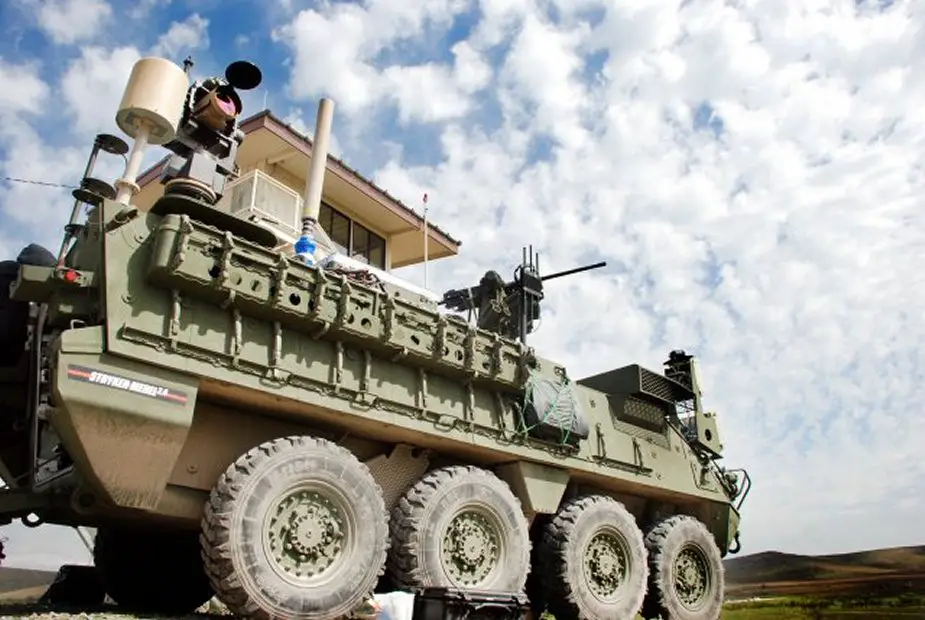US Army focusing on advanced short-range air defense technologies
One of the US Army's current priorities is development of a maneuver system to counter short-range air defense threats such as drones, officials said Wednesday, Feb. 28.

A 5-kilowatt laser sits on a Stryker armored vehicles called the Mobile Expeditionary High Enegry Laser or MEHEL, during the Maneuver Fires Integrated Experiment, or MFIX, at Fort Sill, Okla., April 5, 2017
(Credit: U.S. Army photo by Monica K. Guthrie)
During the last decade, the U.S. military felt it had air superiority over potential adversaries, so Army leaders weren't concerned about having a robust short-range air defense capability. But now, with the worldwide proliferation of unmanned aircraft systems, the Army's perceived need for SHORAD has changed.
While the Army is now fielding new Stinger MANPAD teams to counter drones and cruise missiles, more is needed, Pike said. Stingers have a new proximity fuse which can detonate near a target to destroy small threats such as mini-drones. But in addition to the shoulder-fired Stingers and Avenger Humvees, the Army needs a modern maneuver SHORAD system, he said. It needs a system "on a survivable combat platform like a Stryker, to be able to move out with the maneuver force and protect the maneuver force."
The IFPC is a mobile, ground-based system specifically designed to defeat UAS and cruise missiles, along with mortars, artillery and rockets. The Block 1 system uses an existing interceptor and sensor along with a new Multi-Mission Launcher, or MML, mounted on a medium tactical vehicle. The launcher, which entered a demonstration phase in 2015, can rotate 360 degrees in order to shoot down UAS or cruise missiles incoming from any direction.
The Army has already selected one interceptor for the system, the AIM-9X Sidewinder missile. It has also experimented with a number of other interceptor missiles, since the MML will be able to handle multiple types in its 15 tubes.
The Expanded Mission Area Missile, or EMAM, will be what the Army calls the next interceptor selected for the IFPC. Plans call for the missile manufacturer to be selected next fiscal year,and EMAM will be used with the IFPC Block 2 system.
The Army is also experimenting with directed energy or lasers on the IFPC to shoot down drones.
The High-Energy Laser Tactical Vehicle Demonstrator will put 100 kilowatts of energy into the same vehicle being used for the IPFC, DeFatta said. The laser cannot yet be fired from one of the same tubes already on the IPFC launcher, but DeFatta said that's what some officials would like to see.
This year, SMDC integrated a 60kW laser into a Heavy Expanded Mobility Tactical Truck or HEMTT, and DeFatta said that's never been done before.
SMDC is also experimenting with a 50kW laser in a Stryker-sized vehicle, he added.
The next step is to teach Soldiers how to use such lasers, he said, so a low-power 5kW laser has been put on a Stryker as a technology demonstrator called the Mobile-Experimental High-Energy Laser. The MEHEL was fired last year by Soldiers at Fort Sill, Oklahoma. Today, the MEHEL is in Europe, DeFatta said.
Air and Missile Defense is one of the Army's top six priorities, and Pike said his missile and space budget has more than tripled in the last four years. The Army's Fiscal Year 2015 budget for missiles and space was $2.8 billion, while the FY19 budget request is for $8.7 billion.
(Source: Gary Sheftick, Army News Service)


























